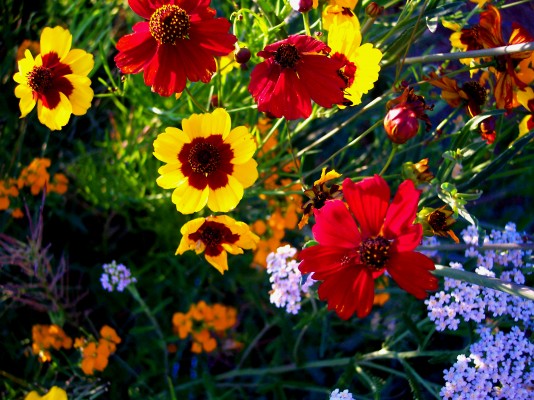From spring forsythia branches to fall garden mums I bring the beauty and fragrance of my garden into the house. Some arrangements are minimalistic and modern; others are full and robust, looking very much like a 16th century Dutch painting. Either way, they grace my desk or a table, or sometimes I take them to a friend.
Arranging flowers cut from your garden is a time honored tradition among gardeners. It’s easy once you let go of the glossy magazine images inhibiting your creativity. So, head to the garden and cut a few stems of greens and flowers recently or just starting to open. (See the tips and Techniques section below.)
After you have cut your selection, begin by choosing an appropriate vase: low for shorter stemmed and smaller flowering, larger and heavy (to prevent tipping) for fuller arrangements. A drinking glass or canning jar will work perfectly fine too.
Determine if you will view only one side of the arrangement or see it all the way around. Most arrangements are one sided, using fewer flowers.
Start your arrangement by greening the vase. This builds the foundation and holds the flowers in place. Select ferns, hosta, tender branches or any combination of interesting leaves. If cutting branches, be sure you practice proper pruning to prevent an unsightly bare spot on your shrub. Let some of the greens drape over the edge if desired. Strip leaves from portion of stem that will be under water.
Next place your “featured flowers” at differing heights. This could be an arrangement of three large roses, a few stems of snapdragons or cone flowers. A good rule of thumb is the arrangement appear as 1/3rd vase and 2/3rds flowers.
Three aspects to arranging (that holds true for container gardens, too) are thrillers, fillers and spillers Well, you’ve just placed your thriller (featured) flower, now add your fillers. These are smaller and less prominent flowers tucked around your main featured flowers. Things like daisy type flowers, salvia and coreopsis to name a few.
Finally add the spiller. These would be cuttings that fall over like floribunda (spray) roses, tuberous begonias or the softer stems of annual eucalyptus.
In the autumn I’ll use the flowering fronds of ornamental grasses to add height and texture.
Flowers with milky sap do not take up water as readily as other cut flowers and will not last as long in an arrangement. Some examples are poinsettia, milkweed, heliotrope, hollyhock, euphorbia and poppy. Most hydrangeas do not work well as cut flowers either.
Experiment with your flowers. Try different combinations. Make miniature arrangements as well as fuller ones. We learn what we like in the doing. So fear not and go cut some flowers!
Tips and Techniques
- Tote a deep stable container filled with water with you into the garden to hold your cuttings.
- Cut stems using bypass nippers or shears; do not use anvil style that will crush stems.
- Cut longish flowering stems just above a node (that bump around the stem where leaves or buds usually emerge).
- To arrange, remove all leaves that would set below the water surface.
- Recut stems to desired length for vase at 45 degree angle using a sharp knife or scissors. To help lengthen their vase life it is often suggested to cut stems under water…I personally have not mastered this technique.
- Help your flowers last longer by using a commercial preservative or by filling a vase with the following solution:
- 2 tbl. fresh lemon juice or white vinegar
- 1 tbl. sugar (use 2 tbl. if using vinegar)
- ½ tsp. household chlorine bleach
- 1 quart warm water
- Keep arrangement cool, out of direct sunlight, away from fans and ripe fruit.
Read Margaret’s reflections on spirituality and nature at Morning Rose Prayer Gardens on Patheos.
Copyright 2013 Margaret Rose Realy
About the Author

Margaret Rose Realy, Obl. OSB
Margaret Rose Realy, Obl. OSB lives an eremitic life and authored A Garden Catechism, A Catholic Gardener’s Spiritual Almanac, A Garden of Visible Prayer: Creating a Personal Sacred Space One Step at a Time, and Cultivating God’s Garden through Lent. An award-winning author, Margaret has a master’s degree in communications, is a Certified Greenhouse Grower, Master Gardener, liturgical garden consultant, and workshop/retreat leader.



.png?width=1806&height=731&name=CatholicMom_hcfm_logo1_pos_871c_2728c%20(002).png)
Comments